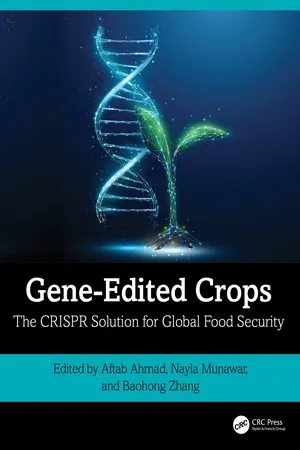
Gene-Edited Crops
The CRISPR Solution for Global Food Security
- 360 pages
- English
- ePUB (mobile friendly)
- Available on iOS & Android
Gene-Edited Crops
The CRISPR Solution for Global Food Security
About this book
CRISPR-based genome editing has revolutionized the precise genetic improvement of agriculturally important crops, offering unprecedented precision and efficiency in crop improvement. This powerful technology holds immense potential to reshape the future of food security, enabling scientists and agriculturalists to develop resilient, high yield crops resistant to diseases, pests, and environmental stresses. Gene-Edited Crops: The CRISPR Solution for Global Food Security offers a comprehensive guide to the latest research, advancements, and real-world applications of CRISPR in crop genetic improvement for sustainable agriculture and food security.
Through in-depth chapters, this book provides an accessible yet rigorous exploration of CRISPR technology, CRISPR reagents and their potential delivery methods, recent developments in CRISPR, and its transformative role in agriculture and food security. With a focus on practical implementation and future potential, this book examines the science behind genome editing and the strategic pathways to address key challenges in crop development—from enhancing nutritional profiles to improving environmental adaptability.
Features include:
- Comprehensive overview: An introduction to the fundamentals of CRISPR technology and its application in crop science.
- Computational tools and CRISPR reagents: Bioinformatic tools for designing precise gRNA, CRISPR reagents and their effective delivery methods.
- Recent developments in CRISPR: Emerging developments in CRISPR for precise gene editing in plants such as base editing, prime editing, Fanzor, and multiplex gene editing.
- Real-world applications: Application of CRISPR for developing future crops, including projects targeting enhanced disease resistance, drought tolerance, and improved nutritional content.
- Regulatory landscape: Insightful discussion on the evolving global regulatory framework governing gene-edited crops, including the transformative role of artificial intelligence in navigating these regulations.
- Future directions: Exploration of ongoing advances and the outlook for CRISPR technology in addressing food security.
With detailed examples, data, and resources, this book serves as an essential reference for scientists, agriculturalists, and policymakers invested in the future of food security. It also doubles as an educational resource for advanced courses in genetics, plant sciences, and agricultural biotechnology, making it invaluable to both seasoned researchers and those newly interested in the potential of CRISPR.
Frequently asked questions
- Essential is ideal for learners and professionals who enjoy exploring a wide range of subjects. Access the Essential Library with 800,000+ trusted titles and best-sellers across business, personal growth, and the humanities. Includes unlimited reading time and Standard Read Aloud voice.
- Complete: Perfect for advanced learners and researchers needing full, unrestricted access. Unlock 1.4M+ books across hundreds of subjects, including academic and specialized titles. The Complete Plan also includes advanced features like Premium Read Aloud and Research Assistant.
Please note we cannot support devices running on iOS 13 and Android 7 or earlier. Learn more about using the app.
Information
Table of contents
- Cover
- Half-Title Page
- Title Page
- Copyright Page
- Table of Contents
- Preface
- About the Editors
- List of Contributors
- Part I CRISPR Technology: Introduction, Design, and Delivery
- 1 Genome Editing: A Renewed Opportunity for Food Security
- 2 Genome-Editing Technologies: A Comprehensive Overview
- 3 CRISPR-Cas Systems for Genome Editing: Evolution, Classification, and Applications
- 4 CRISPR-Design Technologies: Enhancing Accuracy and Precision in Gene Editing
- 5 Available Cargoes and Their Delivery Tools in Genome Editing
- Part II CRISPR-Cas Systems and Their Applications
- 6 CRISPR/Cas9: The Most Widely Adopted Tool for Genome Editing
- 7 CRISPR/Cas12: An Emerging CRISPR/Cas System for Precise DNA Manipulation
- 8 Beyond Traditional Gene Editing: Expanding Applications of CRISPR-Cas
- 9 CRISPR-Based RNA Editing Systems (Cas13 and Cas7-11) in Plants
- 10 CRISPR/Cas-Mediated Base Editing in Plants
- 11 Prime Editing through CRISPR-Cas and Its Applications in Plants
- 12 From Mobile Genetic Elements to Cutting-Edge Genome Editors: Exploring Retrons, CAST, CRASPase, OMEGA, and Fanzor
- 13 Plant Genome Editing
- Part III Applications of CRISPR in Plants: Genetic Improvement to Achieve Food Security
- 14 Genome Editing for Increasing Yield and Improving Nutritional Quality in Staple Crops
- 15 Multiplex Gene Editing and Its Applications: Expanding the Horizons of CRISPR-Cas
- 16 Genome-Editing Tools for Biotic Stress Tolerance in Plants
- 17 Genome-Editing Tools for Abiotic Stress Resistance in Plants
- 18 Abiotic Stress Tolerance Through CRISPR/Cas9-Mediated Genome Editing in Tomato
- 19 Advancing Metabolic Engineering in Plants Using CRISPR/Cas
- 20 Global Regulatory Framework of CRISPR-Edited Plants and Transgene-Free CRISPR Crops
- 21 Innovation, Governance, and Crop Genome Editing
- 22 Combining CRISPR and AI to Facilitate Food Security and Sustainable Development Goals
- 23 The Genome-Editing Toolkit for Food Security: Challenges and Opportunities
- Index